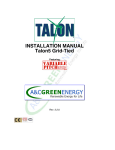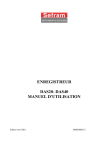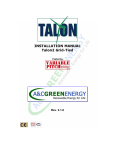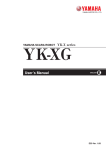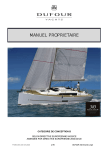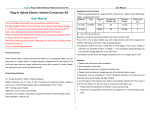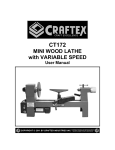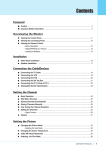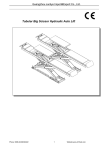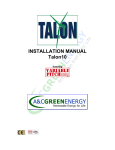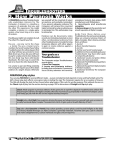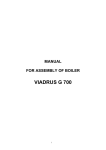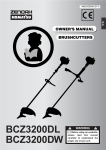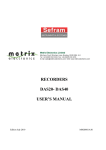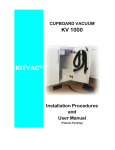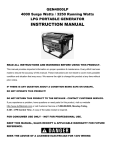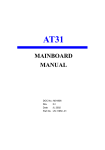Download INSTALLATION MANUAL 20kW Low-Speed
Transcript
INSTALLATION MANUAL 20kW Low-Speed Content 1. Application ……………………………………..…….………..….……………….4 2. Technical specification ……………………….………………….……………..…4 Technical parameter……………………….……………….………..……………..…4 Output Power curve ………………………………….…………..………………….5 3. Structure ………………………………………….…………..…………………....6 4. Preparation …………………………………………..……………………………6 5. Turbine assembly………………………………………………………………..…7 5.1 Nacelle assembly ……………………………………………………………….7 5.2 Tail assembly …………………………………………………………………..8 5.3 Blade assembly …………………………………………………………………9 5.4 Electric winch assembly …………………………………………………………10 5.5 Tower assembly…………………………………………………..……………..10 6. Tower erection……………………………………………..………………..……...12 7. Electric connection ……………………………………………..…………..……...17 8. Maintenance ……………………………………………..………………..………..17 9. Trouble shoot ……………………………………………..…………..…………….18 Appendix 1:20kW 15m freestanding tower foundation …………………………………20 Appendix 2:20W 15m guyed tower foundation ………………………………………21 Appendix 3:20kW15m lattice tower foundation…………………………………………22 Appendix 4:Packing list……………………………………………………………..23 Appendix 5:Wind-solar-diesel hybrid system ………………………………………….24 Appendix 6:AC380V/AC220V grid feeding……………………………………………24 Appendix 7:Bolt torque (Nm) sheet ……………………………………………….25 2 Prior to installation and operation, it is important that you thoroughly read this manual to ensure proper performance and safety. 3 STATEMENT For contents described in this specification, A&C Green Energy can not ensure it is complete and accurate. For the installations which beyond normal ids and installation sites, A&C Green Energy will not make any instruction and guarantee. A&C Green Energy is not responsible for the damage and premium caused under following situations: * Damage caused by the inappropriate operation ; * Damage caused by lightning, typhoon and other force majeure ; * Damage occurred after the warranty expired. Notice:All installation instructions & drawings are valid only with in the warranty period. Note: The smooth and safe installation dependes on the correct operation, technique and carefulness of the operator. Therefore, A&C Green Energy will not be responsible for the unappropriate operation which may cause damage of property & personal injury. The risk will be assumed by user and his operator themselves. Please note: the annual electricity output from the wind generator is determined by the local wind resources and other factor ,such as the installation elevation of wind generator, environmental temperature, maintenance, terrain and density of periphery buildings.Therefore, A&C Green Energy can not make any guarantee for the actual electrical quantity generated by the wind generator. This specification is an general installation guide only, it can not be used as a special maintenance guide, and is not the final assembling and installation documents of the wind generating system. 4 2. Summary 2.1 Information We have improved this specification, but at the same time, A&C is improving its products unremittingly, there may be some difference between the product you received and the specification. Please use original PowerMax+ parts. Do not to refit the original assembled wind generator, otherwise it may caused risk or void the repair warranty. Mark illustration: Warning: means there are risks that may cause personal injury, or perhaps death Caution: means there are risks that may cause wind turbine, equipment or property damage Advice: helpful installation & maintenance hints 2.3 Purpose : • • Off-grid application: The electricity generated by the wind turbine can be stored into batteries, through an off-grid inverter the DC can be changed into stable AC for off-grid power supply; On-grid application: The electricity generated by the wind turbine can be rectified into DC, through an on-grid inverter the DC can be converted into stable AC and feed the local state grid. 2.4 Structure and main property This turbine is composed of blade, permanent magnet generator, nacelle, tower rod, tail rudder, electric winch, dump load, electric controller, battery bank, inverter, cable, etc. (Fig.1) 5 6 2.5 Technical parameter: Type: Blade diameter(m) Blade material/quantity Rated power (w) HY-20KW 10.0 Fiberglass-Reinforced Plastics / 3PCS 20K/30K Rated wind speed(m/s) 12 Start-up wind speed(m/s) 3 Working speed(m/s) 4-25 Survival wind speed(m/s) 50 Rated rpm (r/min) 185 Working voltage (v) Generator type Power supply method Speed regulation Shut down method Tower height (m) DC540 / AC380 Three-phase AC PM Three-phase whole-wave bridge rectifier constant DC voltage charge with output voltage of AC380V, both of On grid and Off grid by Controller and Inverter. Yawing & Mechanical brake By hand or Electric winch. 15M (Optional) Turbine main body Weight (kg) 1370kg Generator lifespan 15 years 7 2.6 Wind turbine Output Power Curve Wind speed(m/s) 0 1 2 3 4 5 6 7 8 9 10 11 12 Output power P(kW) 0 0 0 0 0.03 1.04 3.32 5.28 7.88 10.95 14.11 17.28 20.2 Wind speed(m/s) 13 14 15 16 17 18 19 20 21 22 23 24 25 Output power P(kW) 23.8 26.4 29.16 30 29.83 28.8 28.32 27.35 26.8 25.75 24.85 24 23.25 2.7 Wind Turbine feature : 2.7.1 Blades: With high tip speed ratio and lift over drag ratio, noise of lower than 65db, the blade has been aerodynamically optimized for the better performance.; it has past the wind tunnel test. Made of special purpose gel coat resin and reinforced FRP , the blade is highly durable and will guarantee the safe running under the wind speed of up to 2 times of the rated one; when static it can resist the wind speed of up to 60m/s.It’s wind power efficiency is higher than 0.4. 2.7.2 Made of strong magnet material, and good quality shaft, it has adopted the F grade insulation 8 and IP54 protection as well as the maintenance free design. All this has contributed to over 30000 hours of lifespan. The motor shell has been aluminum coated with power generating efficiency of over 90%. 2.7.3 Nacelle: the nacelle is made of the welded steel plate with high durability and strength. The surface has been galvanized which will protect the nacelle under such harsh environment as: humidity, sand storm, salty mist. 2.7.4 With the wind speed of over 25m/s, the winch will be triggered manually or automatically to let the steel rope draw the tail rudder, consequently the turbine will turn around and gradually avoid the wind direction and slow down the rotation speed. The yawing angle is adjustable: under the yawing angle of 45°~60°, the output power can be reduced to half, when the yaw angle is 80°, the brake trigger attached on the tail pin will let the braking rod to push the braking clip atop the motor shaft so as to slow down the rotation of .This rotational speed regulation mechanism can also triggered by the manual winch either. Fig 2 2.7.5 All of the exposed components have experienced a long effecting anti-corrosion treatment protecting the exposed parts in open pit. 9 3. Safety Rules • • • • • • • • • • It is not allowed for the turbine to run with no load or at a very high speed continually. Check the guyed tower and guy wire regularly, if the guy wire is loose, tighten it timely, so as to prevent the falling of the wind turbine. No one is allowed to stand under the wind turbine when the turbine is rotating with high When the wind speed is over 24m/s, please shut down the wind turbine by hand. If there is vibration or strange noise being detected during operation, please stop the wind turbine for a check. The power supply cable of the wind generator should be set independently; it should never be twisted with other cable. It is more economic for the illuminators to use DC power directly, and the household appliance should be powered by the inverted AC from the turbine; it is recommended for the refrigerator to be equipped with a special plug with an on-delay timer. In wiring the wind turbine system, connect the battery bank first, then the output cable of the generator; in disassembling the turbine system, please disconnect the output cable of the generator before cutting off the battery line. (See appendix 5) The switch of the electric box should be normally put at “on” position. This should only be turned off when the batteries have been fully charged or to protect the system from devastating gust, this switch should be touched only when the turbine is rotating slowly. The battery bank should be put far away from the fire and heat, the harmful gas from the battery charging and discharging should be exhausted timely. Keep the balance of the rotor, eliminate the vibration: When the blades lost balance caused by external damage and have strong vibration, the wind generator must be shut down for a check, until the trouble has been solved. In disassembling the turbine, please remove the big nuts and washer atop the motor shaft by using the attached special tools first. After repairing, the unbalanced torque should be no larger than 0.02N.m. No touch of the “off” switch on the electric box when the wind turbine is rotating fast, the electric box can only be put off when the turbine stop to rotate or rotate slowly! Keep the battery far away from the heat source or fire, the harmful gas emitted during the charging process should be discharged outdoor. Please use the well insulated tool to wire the batteries so as to prevent the short circuit. 10 4. Preparation 4.1 Prepare a suitably long cable 10m ㎡in cross section with a current intensity of around 4A/m ㎡. If the cable is rather long, enlarge the cross section properly. 4.2 The installation site should have comparatively higher average wind speed and weak turbulence since these factors is of great importance to the generator annual power output and safety. 4.3 Prepare the foundation based on the drawing provided by us.(we have the foundation drawing for the monopole tower ,lattice tower and tilt up tower on those soil which can resist the pressure of over 120*10³Pa enclosed in this manual: appendices 1,2 and 3. For other type of soil, the tower foundation should be designed specially. 4.4 Check the component with the packing list, if you have encountered with any problem, contact your PowerMax+ reseller immediately. 11 5 Turbine Assembly 5.1 Tail Vane Assembly Keep the bracket upward, insert the tail vane into the end of tail rod, align the 9×φ13 nozzle, finally fix it by 9 sets of M12×45(also nut, flat washer and flexible washer). (See Fig 3) 5.2 Tail Beam Assembly Fix the rain cover with the 4-M10 nozzle of the tail beam by 4×M10×25 bolt with a spring washer .Align the straight beam and bend beam with the tail rod and fix them by inserting 2 sets of M27×385 bolts with special washer ,put in the nut but do not tighten it (See Fig 4) . 5.3 Tail Rudder Assembly 12 Hoist the tail assembly( combination of tail rod and tail board) and move it to the end part of the turbine, align the 2-φ50 nozzle of the tail assembly with the two nozzles of the sphere bearing of the nacelle ;insert the tail pin into the two nozzles to let the 2-φ18 nozzle on the base of the tail pin align with the 2-M16 bolt nozzle on the bend tail beam, tighten the M16×30 bolts with washer; fix the tail pin by 2 sets of round M45×1.5 nut and thrust washer ;tighten the 2 sets of M27×385 bolt with stipulated torque, insert 5.4 Assembly of steel rope inside the nacelle: Open the head cover of the nacelle,pass the steel rope with the adjustable knot through the jacket and PRR tube of the rope fixing disc,pass the other side of the rope through the orientation pulley 、the top cover and tied onto the tension hookup of the extended arm and fix it by a clamp; after this, close the top cover and fix by screw.( refer to the fig 6). 13 Note:Tighten the rope clamp as the fig 7 show for it’s reliability. 5.5 Braking push rod assembly: Connect the push rod with the tail pin by using two tile shape clamp and 2 sets of M12×40 bolts. The position of the clamp and push rod should be as the fig 8 show, and the clamp will be locked by a thrust bolt as the fig 8 show. At Last, tighten the 4 inner hexagonal bolt M8 one the upper and lower sphere bearing ,after completion of the assembly, close the tail cover and fix it by bolt. 5.6 Blade assembly : 14 Put the blade hub onto a horizontal flat roof with the front side of the hub being upward (to facilitate the tightening of bolt), the three heads of the blade hub has been marked by A, B and C respectively which correspond to the three blades A、B、C. The mark of the Blade hub must match those of the blade, please never mix it. Assemble the three blades onto the corresponding head of the blade hub based on the marks, (blade A should be assemble onto the head A of the blade hub, etc).Set the blade horizontal either by hand or equipment to let the flange of blade and blade hub align together firmly with the concave side being upward, fix the blade onto the hub by bolts (tighten the 4bolts firstly, the tightening of the bolts should be diagonally). After this, check the blade tip: if the tip position is horizontal tighten the rest bolt, if not, dismantle the bolts and assemble again. Assemble the rest two blades onto the hub following the same procedure. (Refer to fig 10) 5.7 Tower assembly: The turbine tower can be divided into freestanding tower, tilt up tower and lattice tower, here we will take the freestanding tower as an example. The tower length is adjustable, ranging from 15~30m combined of several sections; generally, each section will not exceed 9m for convenient delivery, for those towers longer than 18m, it is composed of upper, medium, and lower section. The upper and medium tower section will be connected by plug, and the medium and lower section can be connected by fixing the flange. 5.7.1 Plug the upper and medium tower: Plug the upper tower with the medium tower and lay them onto the ground horizontally, push the two section axially and combine them firmly by using 2 manual blocks pulling the chain and steel rope(the pulling force of each block should be 1~ 1.5t) . 15 5.7.2 The connecting of medium tower with the lower tower: Put the middle and lower tower section together, and let the screw nozzleφ26 of the medium section flange align with those of lower section flange, insert the high strength bolt M24×50 with the flat washer, spring washer and nuts. Screw on the nuts diagonally and tighten them by a torque banner with a stipulated torque. 5.7.3 Assembling the platform: lift the top end of the tower 1m above the ground with the ladder being up, fix it by using a supporting bracket, the support bracket should be 1.2m from the tower head top .Assemble 5 brackets onto the tower, each one should be fixed by four M16×40 bolts, but do not tighten them immediately. Assemble the platform which is comprised of 3 parts by using 18 M12×30 bolts(including the nut, spring washier),connect the platform with the brackets by using 15 M12×30 bolts(including nut, spring washier),after that, tighten the bolts of the bracket and platform with a set torque. Note: the door of the platform should be in line with the maintenance ladder (Fig 11). 5.7.4 Assembling the maintenance ladder: the ladder is comprised of several sections whose standard unit length is 3m.the ladder of the 15m tower is comprised of 3×3m and 1×2.12m sections, the 3m section is fixed by 3 M16×40 bolts (including nuts, and spring washier); those should be arranged from top to the bottom, the last section(1×2.12m) should be fixed by 2~4 M16×40 bolts(including nuts, spring washer). 16 5.8 Connecting the power cable: Open the tower top window, connect the three power cable with the cable terminal inside the tower. Draw three cable (10~16mm² in cross section) from the tower foundation up to the cable terminal inside the top end of the tower, and fix them onto the inside inner wall of the tower by clasp to hold the weight of the cable.(as the fig 12 show) 6 Whole machine assembly and installation 6.1 Safety note for installation The turbine is forbidden to be installed under extreme weather condition, such as storm, lighting, heavy fog, sand storm, and hurricane. The installer should be familiar with the surrounding environment and must clear the obstacle nearby beforehand. . Keep the installation site far enough from the electrified body. . Those who have the elevation qualification can be allowed to climb atop the tower. 6.2:Installation of turbine machine by crane 6.2.1 Installation site Clean up: Clean up the thread of the feet bolt and the foundation platform, meanwhile, prepare all the necessary nuts, flat washer, spring washer needed. 17 6.2.2 Lift the tower (fig 13): Hoist the tower by a steel rope (over 15M) by passing the rope through the opening atop the tower, and put it onto the foundation platform which is ready. 6.2.3 Adjust the Perpendicularity of Tower: Measure the perpendicularity of the tower by the gravity line method, then adjust the perpendicularity of tower by adjusting the upper and lower nuts, finally tighten the nuts by torque spanner. 6.2.4 Main Machine Assembly Before the lifting of the turbine, fix the tail rudder with the position fixing rubber block by a steel wire to prevent any possible damaged caused by the swing of tail. Lift the turbine onto the tower top by crane, and then affix the turbine body with tower top flange by bolts under the coordination of installation engineer. (See Fig 14,15) 6.2.5 Generator Output Cable Connection: Open the maintenance window atop the tower, and then affix the three output cable of the generator onto the cable fixing board inside the tower. (See fig 12) 6.2.6 Turbine Assembly: (Fig 16) Short connect the three output cables of the generator at the bottom of the tower by insulation tape lift the turbine and move to the front head of the turbine body, insert the generator main shaft into 18 the nozzle of the blade hub slowly, put in the washer and the M56 nut, tighten the nut with a torque of 1500~1700Nm and lock it by M8×20 screw. 6.2.7 Nose cone assembly:(Fig 17) Assemble the nose cone by 12 sets of M12×40 bolts (with flat washer, spring washer) 6.2.8 The assembly of steel rope and braking system inside the tower: (Fig 18) Affix the bracket of winch onto the bottom of the tower by using 4 sets M12*40 hex bolts then fix the winch onto this bracket and fix by M10*40 hex bolts. Finally assemble the stroll switch. Lengthen theφ6 steel rope based on the tower height, the length should be: tower height -5m; spread stain proof grease around the connecting part and steel rope inside the winch; connect one end of the rope onto the winch, pass the other end of the rope through the swing fork into the tower, and draw it out from the up window of the tower and connect with the detachable link chain beneath the vertical shaft. (See fig 6) 19 6.3. Brace Strut Lifting Method (when a crane is not available) This method is suitable in those areas with poor traffic conditions (Fig 18). 6.3.1 By using this method, the maximum wind speed for the installation of wind turbine is 4m/s; 6.3.2 The bare tower should be erected beforehand (with no turbine being assembled) to check the state of the equipment, tools and whether the crew is ready for installation; 20 1. Assemble the tower rod first, and fix it onto the tower base by a gemel, tie the right, left and rear guy wire onto their respective ground anchor, then tie a soft wire (16mm in cross section and 10m in length) onto the rear guy wire for manual operation.(the tower being assembled should be straight, if it is over bending, an adjustment is needed).; b 2. Lay down the holding rod toward the tower and fix it onto the tower base by a gemel, affix a saddle type iron plate onto the top of the holding rod, then tie four guy rope onto the holding rod with the left and right guy wire being connected with the left and right ground anchor; affix the rear guy rope with the hanging ear of the tower rod to let the two rod form an approximate 90°angle ,the front guy rope of tower should be connected with the steel rope of the hand winch. 3. Start up the winch for a trial operation, then shut it down; pass the steel rope of the winch through the ground anchor pulley, movable block sets and fixed block sets then tie one head of the rope onto the base of winch or ground anchor; connect the pulley group with the front guy rope and tie this rope onto the top of the holding pole , during the lift of the holding pole, please adjust the right and left guy rope of the holding pole so as to keep the movement of the pole will be in the same plane ;keep an appropriate tightness on the guy rope ( when the hoister is not available, other dynamic equipment such as truck should be used). Start up the hoister for a trial operation and shut down it ;pass the steel rope of the hoister through the ground anchor pulley, fix pulley and tie one end of the rope onto the base of hoister or foundation anchor; connect the pulley with the front guy rope of the tower and fix it onto the end of holding bar; lift the holding bar gradually by hand winch to the vertical position, during the lifting process, keep the holding bar within the same lifting plane by adjusting the right and left guy rope; keep an appropriate tightness of the guy rope (other dynamic equipment such as truck should be used in the absence of winch). 4. Straighten the steel rope and pulley group, pass the steel rope through the ground anchor pulley and tie it onto the winch horizontally; start up the winch until the pull rope is tighten, 21 then pause and check all the fasteners and connecting points, as well as the tightness of the left/right pull rope of holding rod and tower rod respectively; start up the hoister again, during the lifting, keep tightening the temporary front guide rope of the holding rod continuously by a hand winch and keep the holding pole and tower within the same plane, meanwhile please watch and adjust the tightness of the left/right pull rope all the time, when the angle formed by the tower and ground exceeded 70°, stop the hoist; check and make sure the pulley group have enough back setting allowance, so as to prevent the movable and fixed block from bumping with each other; Check if the tightening mechanism of the left/right pulling rope is smooth, adjust the brake of the bumper/holding soft rope. If there is no safety risk during lifting, start up the hoister to release the steel rope while holding the temporary front holding rope at the same time. Support the tower by a 2m wood bracket 4~5m from the tower top. 22 5. After the trial test of the pole, check the ground anchors, tie point of the steel rope, equipment and begin the formal installation. 6. Assemble the nacelle, tail rudder, wind turbine and output cable as well as the wire of the winch, and connect the vertical bearing with the tower top in accordance with sections 5.1, 5.2, 5.3 and 5.5.6 of the user manual. 7. Short connect the three output cable of the turbine. 8. After the installation, adjust the weight position of the turbine main body to prevent the turning of nacelle and tail rudder during lifting for the safe operation. 23 6.3.3.2 Start up the winch to lift the turbine until the turbine leave the bracket then pause it to see: if there is abnormal phenomenon on all of the ground anchor, connection of guy rope and holding rod, the flexible tower holding rope, temporary guide wire and other condition. After this check, start up the hoister again, during the process keep tightening the front guide rope of the holding rod and observing the tightness of the right/left guide rope and holding rope; lift the turbine slowly by inching the hoister once the angle formed by the tower and ground has exceeded 70°.Lay down the tower by careful adjustment of the tightness of the three guy rope as during the falling down of tower, the gravity center is difficult to control. 6.3.3.3 Hold the front pulling rope of the tower, disconnect the pulley group from the front pull rope and tie the front pull rope onto the front ground anchor; remove the hoister, pulley group, holding rod and other lifting equipment; adjust the perpendicularity of the tower against the ground by adjust the four pull rope, tighten the pull rope properly and tighten all the fastener with a stipulated torque; lock the buckles on the four pull rope and check the all the connection is firm, spread an anti-corrosion grease around all the connecting point . A. The figure 23 show the status of the tower and all the parts before being lifted, L1 represent the distance between the ground anchor pulley and holding rod which is about 2.6 time of the height of the center point of the tower.H1(holding rod height) is about 1/2~3/5 of the tower height. The main draft line of the holding rod should be connected with the hoister by a ground anchor pulley. B. In the figure 21, the turbine has been assembled onto the tower and the tower has not been lifted; the turbine is supported 2m above the ground by a bracket 4~5m from the tower top; after the assembling of the turbine, fold the tail and balance it. (The angle formed by the right side nacelle, nacelle axis line and tower should be around 60°). C. In the figure 22 the angle formed by the tower and ground has exceeded 70, the hoister should be driven slowly by inching, hold the flexible rear holding rope at the same time. Lay down the tower 24 by careful adjustment of the tightness of the three guy rope as during the falling down of tower, the gravity center is difficult to control. The assembly of steel rope inside the tower and brake mechanism please refer to “6.2.8” 7. Electric connection: 7.1 Off-grid type wind turbine system 7.1.1 System diagram (Diagram refer to Appendix 4) 7.1.2 System Brief The wind power generator is equipment converting the kinetic energy of the moving air mass into 25 electric power. It enjoys a wide usage in those wind rich areas where there is no access to the normal power supply. It is capable of powering the lighting, TV, telecommunication equipment etc through an off-grid inverter for the off-grid power supply application. 7.1.3 Combine the batteries into battery bank, the “+” pole and “-” pole on both end of the battery bank is marked by red and black color respectively. The battery line and guide cable should be 10mm² in cross section. All the wire connecting part should be fixed by a wire clip to guarantee smooth electricity transmission. Spread a layer of grease around the wire terminal and wire clip to protect them from corrosion. Connect the “+” pole of the batteries with the “+” pole output terminal of the electric box (controller & Inverter); tie the black wire ( “-” pole )of the batteries onto the “-” pole output terminal of the electric box. (Controller & Inverter). The connection must be firm to ensure good electric conductivity. Connect the three output cables of the generator with the three terminals of the electric box respectively. There are both DC and AC terminals on the electric box please connect it based on the mark. For installation detail please refer to the user manual of the controller and inverter. 7.1.4 The off-grid wind turbine system can be put into usage upon the completion of wiring based on the relevant diagram. Let the wind turbine charge the battery first, when the battery has been charged enough for the inverter, the inverter will be ready for power supply. 7.1.5 The battery must be recharged timely after the discharging to guarantee its lifespan. Please adjust the load based on your local wind condition and output power of the turbine to prevent the over-discharging and the subsequent damage of the battery. 7.1.6 The voltage of the battery should be equal to the wind turbine voltage,the DC output voltage of inverter should also match the voltage of wind turbine,the capacity of the inverter should be based on the peak power level of the load. 7.2 On-grid wind turbine system 1 2 System diagram (the system diagram please refer to the fig 5) System brief 26 The on-grid wind turbine system is composed of the turbine body, on-grid controller, dump load resistance box, on-grid inverter and affiliated electric system. The kinetic energy of the moving air mass will be converted into AC electric power by the wind turbine equipment, through a controller. This unstable AC will be changed into DC and converted back into stable AC through an on-grid inverter. This AC power can either be fed back into grid or used by the load. 7.2.3 Connection of the on-grid wind turbine system Wire the on-grid system based on the user manual of controller, inverter and wind turbine, the cross section of cable、safety note should all be based on the actual controller ,inverter selected. 7.2.4 The capacity of the dump load should be 2-3 times of the capacity of inverter. The wiring diagram in the appendices 4 and 5 of this user manual is only applicable for the controller and inverter from our company only. For the wiring of the on-grid wind turbine system (refer to appendix 6) 27 8. Operation 8.1 Checking before operation 8.1.1 Checking all fastening parts of blades, rotor, and follow guiding cover, generator with nacelle, outside part of nacelle and tail vane, ensuring they are tight and reliable. 8.1.2 Check the blade assembly angle to make sure the folding and recovery of tail vane is correct. • • Check the connections of tower rods, the connections between tower rod and foundation bolts, ensuring the stipulated tightening torque have been reached. Rotate the rotor and check that there is not blocking or friction on the generator or hydraulic braking device. 8.2 Checking output circuit line of generator 8.2.1 Open the right door of the nacelle, checking whether the connection between three output lines and electric brush is in good condition and is tightly and reliable. 8.2.2 Check the conducting performances between each end and slip ring and ensure they are good at electricity conduct by using universal electric meter. 8.2.3 Check the contact between the three output cable of the wind turbine and the connecting cable, see if the cable head has been fixed firmly; is there any friction between the cable or steel rope. 8.3 Checking yawing mechanism and hydraulic braking device 8.3.1 Check the connection between the winch and steel rope. 8.3.2 Shut down the turbine machine and crank the winch by hand and see if there is any stagnation during the folding of tail vane. 8.3.3 Start the turbine; release the winch until the steel rope is loose. Check if the tail will recover its position quickly. Make sure the turbine can be moved. 8.4 Checking the electric equipment which matched with wind generating system Checking the electric equipments which matched with wind generating system, ensuring they met the requirement of power supply, technical state is good, connections of lines are correct. 8.5 Trial Operation 8.5.1 The wind turbine should be shut down before the running. 8.5.2 Operating wind generator, checking the wind facing flexibility of the wind generators, When wind speed is 4m/s, the wind turbine should rotating in response to the changing of wind direction. 8.5.3 When wind speed is more than 4m/s, rotor should start rotating. For the new equipment, when they are put into operation, because of the friction between braking disk and braking slice, the 28 starting wind speed may be higher, this is normal, after a short time running, the friction phenomena will disappear automatically. 1 、During the operation period the wind turbine should be steady and Thanks for choosing our products without obvious vibration, checking the three output lines of the generator and their voltage should be equal; when wind speed is more than rated wind speed, the rotor should have obvious yawing action, peak value of power output is not more than 1.8 rated power in big strong wind conditions. After passing above examination, and ensure the technical conditions are satisfied, then the wind generating system can be put into operation. 1 Upon the completion of the assembly of wind turbine, please operate the turbine system in accordance with the user manual of the controller and inverter monitor and make sure the controller, battery bank and inverter will work normally the inverter will power the load or feed the grid normally. 2 The turbine system will be put into application after the above mentioned check. It’s normal for the turbine to require a little bit higher start up wind speed than the normal one initially, it will be normal later. 29 8.6 Normal operation 1 During the trial operation, make sure all systematic part are in the normal status, and have no other fault. 2 The system must be operated by specially trained personnel. 3 The operation must obey strictly with the regulation. 8.7 Normal shut down 8.7.1 Automatic shut down: The controller of turbine will keep monitoring the output voltage and current of the turbine. If any of the parameters exceed the set level, the system will automatically shut down for protection. 8.7.2 Manual shut down: If the turbine need to be shut down manually either because of the need of repairing, typhoon is approaching or automatic shut down mechanism break out, please trigger the manual dump load switch on the controller to increase the load of wind turbine and slow down its rotation speed then press the manual braking button on the controller or operate the winch by hand directly to let the turbine fold it’s tail and shut down. 8.7.3 When the turbine will be shut down for a long period, the controller and inverter should be switched off to prevent over-consumption of electricity stored inside the batter which will impair the lifespan of battery. 8.7.4 Recovery: The turbine should be restarted by manual winch after it was shut down both by manual or automatic method. Please switch off the inverter before the controller. For the switch-on operation, follow the same procedure. 30 9. Check and maintenance 9.1 The routine checking 9.1.1 Checking whether wind generator is operating smoothly, if there are any strange vibration and noise, should stop the wind generator and making a further checking and eliminating the problem. 9.1.2 Observing that when wind speed is more than rated wind speed, whether the yawing action of the wind generator is easily and smoothly. 9.1.3 Carefully observing the three phase output is balanced or not, the power output is in normal conditions or not, the “flow diversion or discharging” should be kept unblocked and reliable. 9.1.4 Checking the charging of battery is sufficient or not, checking the technical conditions of electric winch is good or not. 9.2 The checking & maintenance after First 1000h 9.2.1 Checking all the fixing parts, if there is some loosening, please tighten them in accordance with the stipulated torque. Checking emphasis are: the nuts of foundation bolts, linkup flange bolts of tower rods, the bolts connecting the vertical shaft flange and tower top, fixing nuts of rotor hub, fixing bolts of blades, fixing bolts of air flow diversion cover, fixing bolts for connecting generator and nacelle, round nut on the bearing of vertical shaft, up & down round nuts and bolts of the main tail pin. 9.2.2 Checking welding positions of tower rod (emphasis are root part, linkup flanges and tower top flange), rotor hub, tail beams, ensuring there are not cracks and flaws. 9.2.3 Checking hand turning and winch driving tail folding action(tail fold to 45°~60°), to see whether there are any blocking phenomena; checking whether the tail vane can restore easily after releasing, if there are some unusual conditions, please ascertain the reasons and eliminate the breakdowns. 9.2.4 Checking whether the fixing bolts of blades are loosened & missed or not, checking whether the fixing bolts of air flow diversion cover are loosened & missed or not, ensuring they are completed and fixed tightly. 9.2.5 Checking output circuit lines of generator. 9.2.5.1 Checking the three output lines of generator, to see whether they are fixed firmly in the nacelle, whether their wire covers are broken . 9.2.5.2 Checking the connection between the three output lines and electric brushes, ensuring they are firmly fixed and conducting contact is in good conditions. 。 9.2.5.3 Checking the contact between 6 brushers and electricity conveying slide ring, to see if there are any wrong contact and over heating or burning phenomena. 31 9.2.5.4 Checking the three phase output voltages, to see whether they are balanced. 9.3 Checking after big strong wind After suffering first big strong wind (>25m/s), should re-check 9.2.1,9.2.2,9.2.3,9.2.4,9.2.5. 9.4 Routine checking & maintenance after every 3000h operation 9.4.1 Repeating every checking & maintenance in 9.2. 9.4.2 Checking the technical conditions of rotor. 9.4.2.1 Checking the contour of blades, emphasis on tip and front edge, to see whether there are any cracks, wane and damage. 9.4.2.2 Checking the blades, to see whether there are any changes which can result in unbalanced deform, translocation and change of setting angle. 9.4.3 Cleaning the electricity conveying slip ring and electric brushers, polishing its electricity conducting contact face, over wearing electric brush should be replaced by new one, but the new brush need to be run, the contact area between brush and slip ring should reach to 95% or more. 9.5 Maintenance 9.5.1 Check the fastener and graphite brush regularly. 9.5.2 Check the steel rope regularly and replace it, if necessary. 32 Phenomena of breakdown Wind speed is bigger than 4m/s, But rotor Can not rotate Direction adjustment (facing the wind) is not nimble The rotating speed of rotor is obviously rather lower Vibration of wind turbine Unusual noise Occurring reasons Eliminating methods 1. Setting angle of blades is too smaller 2. The rotor has not passed a balance test, or one blade is overweight and sagging. 3. Starting resistance torque of generator is bigger 4. Short cut occurred in the output circuit of generator, or load has been accepted in advance. 5. Braking mechanism is blocked The tower rod is not in vertical state or the bearing of vertical shaft is too tight and making the rotor can not facing the wind direction 1. Bearing rotating resistance of vertical shaft is bigger 2. Tail vane do not restore 1. Adjusting according to the design 2. Carrying out static state balance in accordance with technical requirement 3. Checking the resistance torque of generator, ascertaining the reason and eliminating the problem. 4. Ascertaining the short cutting positions; Postponing the acceptance of load 5. Ascertaining the friction positions, eliminating the friction phenomena. 6. Adjusting the tower rod to vertical state; if the bearing of vertical shaft is too tight, it should be adjusted to a rather loose state 1.Setting angle of blades is too bigger 2.Resistance of generator bearing is bigger, or the bearing is damaged 3.There are shortcut in the output circuit of generator 4.Load is not matched 5.The friction of braking mechanism has not been released 1.The fixing bolts of blades are loosened 2.Water entering the blade, freezing, rotor lost balance 3.There are wane or damage on blade, causing power and gravity lost balance 4.Generator, power outputcircuit(including electricity conveying slide ring) is losing electricity current and phase. 5.The vertical shaft bearing of nacelle is loose or damaged. 6.The bearing of tail vane is loose or damaged. 7.Braking mechanism is blocked intermittently. 8.Wind turbine is rotating in high speed at yawing state. 9.Wind turbine is rotating in over speed state 1. Adjusting in accordance with the design requirement 2. Checking, replacing it by a new one 3.Eliminating the shortcut 4.Adjusting working voltage, load adding work point 5. Ascertaining the reasons of friction & blocking and eliminating the problem. 1.The fixing parts of rotor rotating part is loose 2.The three phase of power output are not balance 3.The bearing of generator is loose or damaged 4.The bearing of vertical 1. Adjusting the clearance of bearing, or replacing the bearing 2.Ascertaining the reason and restoring the tail vane to its normal position. 1. Replacing new bolts, tightening them in accordance with stipulated torque. 2. Eliminating accumulated water or ice, adjusting the rotor to balance condition 3.Repairing the blades, and adjusting the balance again 4.Checking whether the three phases output are balanced , checking from wire connecters of electricity controlling box to output wires of generator progressively 5.Tightening it in accordance with the requirement or replacing it with a new one. 6.Ascertaining the friction or blocking positions, repairing and eliminating 7.Checking branch braking pump, braking disk and braking slices 8.Checking braking device and the size of yawing angle 9.Checking the load of controlling box (including shunt), adjusting and tracking, increasing the load properly 1. Ascertaining the loose part, the fixing parts of key positions should be replaced by a new one 2.Checking generator, controlling circuit, loading; Ascertaining the reason of stoppage and eliminating it. 3.Ascertaining the damaged 33 shaft is loosen 5.There are frictions in braking mechanism 6.Parts inside the nacelle are loose 7.The bearing of tail vane is loosen 1.The fixing parts of framework and tail vane are lose 2.Causing resonance owing to over speed rotating of the rotor Rotating speed of the rotor is too high, even exceeding the limited rotating speed There are breakdowns in electricity supply circuit, the wind turbine can not be stopped 1.Operating without any load 2.Load is too small 3.Yawing action of the rotor is difficult, adjusting & controlling action is slow 4.The tower rod is not vertical to horizontal plane, so as to effect the normal actions of yawing mechanism 5.Yawing angle is not enough 6.The bearing of tail vane is blocked and causing the tail vane unable to fold freely 1. There are breakdowns in controller, it can not shunt and unload when wind turbine is over powering or over speeding 2.Energy consumption capacity of the shunt— unload device is not sufficient 3.Yawing mechanism, braking system are out of order bearing and replaced it by a new one 4.Adjusting the clearance 5.Checking and repairing the mechanism, so as to eliminate the frictions 6.Tightening them to eliminating the loosen phenomena 7.Replacing new parts 1.Tightening them and eliminating the problem 2.Stopping the wind turbine, Ascertaining the reason, after eliminating the problem, starting the wind turbine again 1.Stopping the wind turbine, eliminating the problem 2.Adjusting & controlling the matching relationship between output power of wind turbine and load 3. Adjusting the inclination angle, to suit the local wind conditions 4.Adjusting the vertical degree in accordance with the requirement of specification 5. Adjusting tail folding angle to 75°~80° 6. Checking & repairing to eliminate the problem, or replacing it by a new bearing 1.Eliminating the breakdowns of controller 2.Increasing the Energy consumption capacity properly 3.Ascertaining the reasons, repairing and eliminating the problem, braking torque must bigger than 350Nm 34 Appendix 1: 20kW-15m freestanding tower foundation 35 Appendix 2:20kW-15m lattice tower foundation drawing (the minimum tolerance pressure of the soil should be over 120*103Pa. 36 Appendix 3:20kW-15m guyed tower foundation drawing (the minimum tolerance pressure of the soil should be over 120*10³Pa) 37 Appendix 4:Packing list Component Quantity Package Blade 3 Wooden box Tail vane+tail rod 1 Soft package Nacelle+motor 1 Wooden box Blade hub 1 Wooden box Nose cone 、rear cover 、tail plate 1 Wooden box Controller/inverter(optional) 1 Wooden box 42 (variable) Wooden box Battery bank(optional) Electric brush 6×1 For free 6m For free Wire clamp M6 1 For free Flexible ringφ10 1 For free 1 For free 2×1 For free Steel wire sheath 4 For free Vertical shaft M16×70 12 for free Blade bolts M16×55 16 For free Tool box 1 1 For each patch User manual 1 Stainless steel wireφ6 Accessory Oil sealφ110×φ80×12 Braking Tool Reference User manual for inverter 1 Certificate 1 38 Appendix 5: Battery gathering Energy, Wind, PV, Diesel hybrid power supply way. 39 Appendix 6: Power Application AC380V/AC220V Appendix 7: Bolts Tightness Table (Nm) Performance Grade 35、45 HB101~207 16MnVB、45 HB285~321 40Cr、40MnB HRC35~40 5.6(σs =300MPa) 8.8(σs =640MPa) 10.9(σs=800MPa) M6 4~6.5 6~12 M8 8~15 16~30 M10 18~30 36~63 M12 30~47 70~110 90~135 M16 85~127 180~210 220~300 M20 167~250 350~410 440~520 M24 300~460 580~650 820~900 M27 450~600 775~880 1085~1198 M30 510~680 870~985 1220~1350 M36 660~745 1250~1420 1760~1940 M42 1705~1930 2390~2640 M45 1820~2165 2670~2965 M48 2230~2520 3125~3450 M56 3035~3430 4250~4695 40 41











































